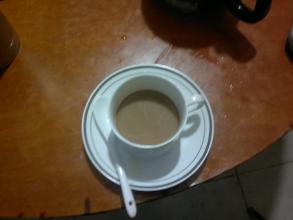Why hot milk can be beaten out of cold milk can not be beaten out of what is the principle caused
The milk used in milk latte drinks has a fat content of about 3%. The less fat, the harder the foam. What you want is smooth foam (so forget about fat-free cappuccinos).
The main thing to keep in mind when foaming is to stop when the temperature reaches the right point. The appropriate temperature refers to 55-65 °C, depending on your taste. Foaming for too long will condense the milk and change its taste (and cappuccino will be too hot). Overheated milk can also make the foam too hard. How different will the foam be? Here are some typical examples:
Blistering if you are distracted or distracted when foaming, it is easy to cause the steam pipe to be above the surface of the milk rather than just below the surface of the water. The result is milk spatter and larger milk bubbles. Of course you can still get a lot of foam in the flower cup, but it will taste bad. : (
The hard foam looks so stiff that it doesn't mix with the coffee when you pour it into the coffee, but accumulates on top of your coffee like fluffy beaten cream. If you play a little longer, it will be layered, 90% of which is flowing milk, and a thick hard foam lid floating on it. When you pour it into the coffee, the milk will flow out of the flower cup first. You must scoop the foam into the coffee cup with a spoon. Smooth if you do everything right, when you pour it out, the milk looks smooth and creamy, a bit like pouring yogurt. Milk your espresso will mix perfectly, and crema will color the surface of the milk to form a typical brown edge of cappuccino.)
Milk that has been beaten again often makes hard foam. The trick is to beat the right quantity and quality of foam in the flower cup at the right temperature. To foam well, you need to know how quickly your machine heats up the amount of milk you want. A good advice is not to take less than two cappuccinos at a time when you start learning to foam.
Vapour
After the machine reaches the correct temperature, turn on the steam switch, release the water that always exists in the steam pipe, and then turn off the steam switch.
Put the nozzle under the surface of the milk and turn on the steam. If you turn on the steam when the nozzle is above the liquid level, you will get larger bubbles, and it will take a lot of effort to get rid of these bubbles.
Slowly take the nozzle to the surface of the milk. Stop (stop just as it breaks the surface) just as the nozzle is about to come off the surface. Now that the air is sucked into the milk, you will hear a typical hiss. If you accidentally take the nozzle out of the water, the pressurized air will blow on top of the milk instead of into the milk, resulting in large bubbles.
At this stage, there is no doubt that you have formed small and medium-sized bubbles on the surface of the milk. Now we will try to get rid of them. There will be a whirlpool where the air blows into the milk. All the bubbles on the surface will be pulled into this whirlpool and disappear. It is still important to put the nozzle in the right place to avoid new bubbles.
Now you have a texture made of tiny bubbles. Put your empty hand on the flower cup to feel the temperature of the milk. When the foam rises, you lower the steam pipe carefully so that it touches the milk. If you are satisfied with the amount of foam and the milk is not warm enough, you can lower the nozzle into the milk. Now the milk is beginning to swirl. By doing so, the milk can be evenly heated by steam. When your hands feel a little hot, keep the nozzle below the liquid level and turn off the steam.
Whirlpool and pouring will still have bubbles in your foam most of the time. A good way to get rid of these bubbles is to tap the flower cup on the workbench. Don't knock too many times so as not to cause too much foam. A good way to judge whether the milk is thick enough is to rotate the flower cup so that the milk begins to form a whirlpool. You have to make more cappuccinos to learn what milk should look like. But here are some suggestions.

Important Notice :
前街咖啡 FrontStreet Coffee has moved to new addredd:
FrontStreet Coffee Address: 315,Donghua East Road,GuangZhou
Tel:020 38364473
- Prev

Coffee eyedropper with the best pick-me-up effect.-what's the pick-me-up effect of black coffee?
Stephen Miller, a neuroscientist at the University of Health Sciences Unified Service in Maryland, found in 2013 that drinking coffee when cortisol levels peaked between 8am and 9am was not the best pick-me-up and produced tolerance to caffeine. Cortisol is an important hormone that can help the body regulate the biological clock and improve alertness. The rise and fall of cortisol level in human body
- Next

What factors affect the production and sales of coffee? what are the factors that affect the taste and flavor of coffee?
Because these countries often experience political instability, markets react so quickly to any problems in these countries. The first thing to bear the brunt is that when dealing with these events, the coffee supply capacity of these countries is at risk of potential decline. During such a period, the price of coffee rose accordingly. As you might expect, the impact of problems in Brazil and Vietnam on coffee prices
Related
- What brand of black coffee is the most authentic and delicious? what are the characteristics of the flavor of the authentic Rose Summer Black Coffee?
- Introduction to the principle and characteristics of the correct use of mocha pot A detailed course of mocha pot brewing coffee is described in five steps.
- Which is better, decaf or regular coffee? how is decaf made?
- How much is a bag of four cat coffee?
- How about four Cat Coffee or Nestle Coffee? why is it a cheap scam?
- Which is better, Yunnan four Cats Coffee or Nestle Coffee? How about cat coffee? is it a fake scam? why is it so cheap?
- How about Cat Coffee? what grade is a hoax? which instant coffee tastes better, four Cat Coffee, Nestle Coffee or G7 coffee?
- Process flow chart of coffee making-Starbucks coffee making process what coffee tastes good at Starbucks
- The top ten best coffee beans in the world Rose summer coffee or Tanzanian coffee tastes good
- Yunnan four cat coffee is good to drink?_four cat coffee is a big brand? four cat blue mountain coffee is fake?

